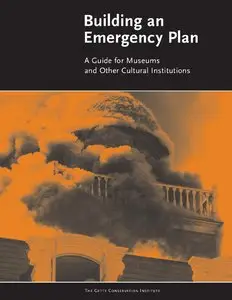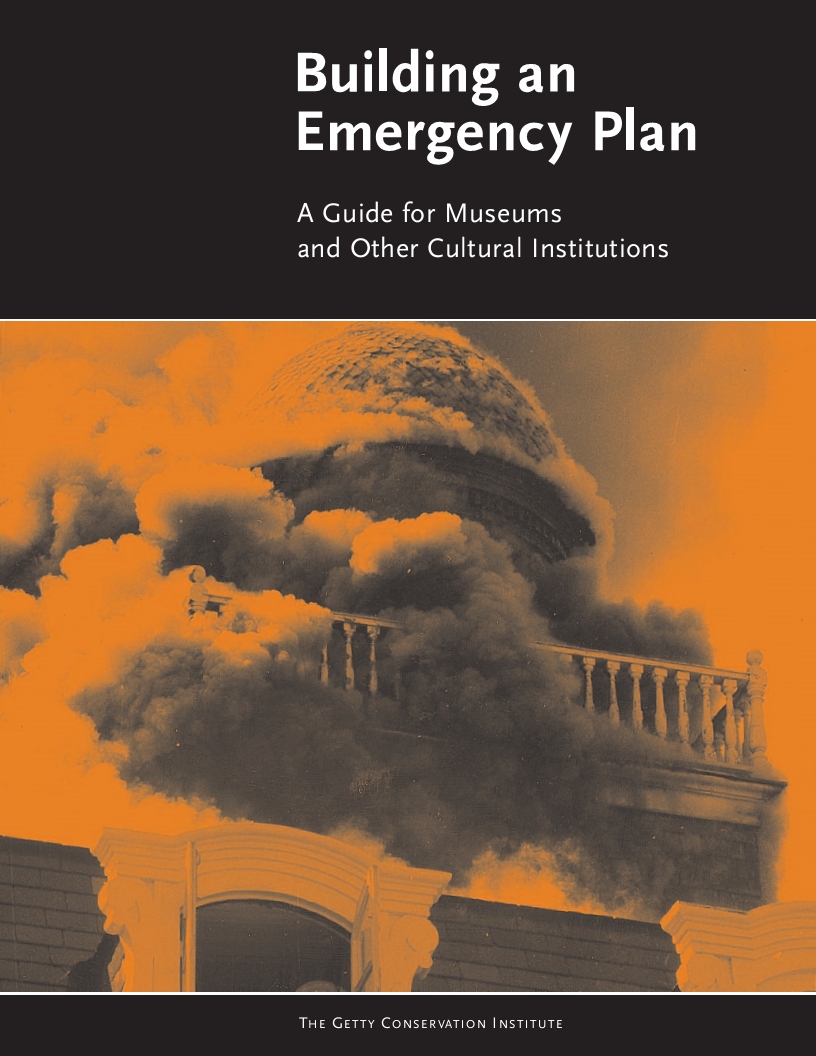Valerie Dorge, Sharon L. Jones, "Building an Emergency Plan: A Guide for Museums and Other Cultural Institutions"
Publisher: J. Paul Getty | 1999 | ISBN: 089236551X | English | PDF | 280 pages | 3.1 Mb
Publisher: J. Paul Getty | 1999 | ISBN: 089236551X | English | PDF | 280 pages | 3.1 Mb
Building an Emergency Plan provides a step-by-step guide that a cultural institution can follow to develop its own emergency preparedness and response strategy. This workbook is divided into three parts that address the three groups generally responsible for developing and implementing emergency procedures—institution directors, emergency preparedness managers, and departmental team leaders—and discuss the role each should play in devising and maintaining an effective emergency plan. Several chapters detail the practical aspects of communication, training, and forming teams to handle the safety of staff and visitors, collections, buildings, and records.
Emergencies covered include natural events such as earthquakes or floods, as well as human-caused emergencies, such as fires that occur during renovation. Examples from the Barbados Museum and Historical Society, the Museo de Arte Popular Americano in Chile, the Mystic Seaport Museum in Connecticut, and the Seattle Art Museum show how cultural institutions have prepared for emergencies relevant to their sites, collections, and regions.
Foreword
Timothy P. Whalen
Preface
Valerie Dorge
Introduction
How to Use This Book
Terms to Know
Part I: For the Director
Chapter 1: An Introduction to Emergency Preparedness and Response Planning
Facing the Facts
The Emergency Preparedness and Response Planning Process
Devising the Emergency Plan
Taking a Cue from Other Institutions
Case 1: Barbados Museum and Historical Society
Case 2: Museo de Arte Popular Americano
Case 3: Mystic Seaport Museum
Case 4: Seattle Art Museum
Chapter 2: The Role of the Director
Creating an Emergency Plan
A Team Effort
Immediate Steps to Take
Part II: For the Emergency Preparedness Manager
Chapter 3: The Role of the Emergency Preparedness Manager and the Emergency
Preparedness Committee
Making Emergency Preparedness Happen
The Role of the Emergency Preparedness Manager
The Role of the Emergency Preparedness Committee
Chapter 4: Communications
Why Communication Is Important
Developing an Effective Communications Program
Chapter 5: Training
Why Training Is Important
Who Should Be Trained?
Where to Start?
Emergency Preparedness and Response Training Suggestions
Part III: For the Departmental Team Leaders
Chapter 6: The Safety and Security Team
Your Role in the Process
Preparing Report 1: Vulnerability and Asset Analysis
Preparing Report 2: Outline of Response Procedures and Techniques
Chapter 7: The Collections Team
Your Role in the Process
Preparing Report 1: Vulnerability and Asset Analysis
Preparing Report 2: Outline of Response Procedures and Techniques
Chapter 8: The Buildings and Maintenance Team
Your Role in the Process
Preparing Report 1: Vulnerability and Asset Analysis
Preparing Report 2: Outline of Response Procedures and Techniques
Chapter 9: The Administration and Records Team
Your Role in the Process
Preparing Report 1: Vulnerability and Asset Analysis
Preparing Report 2: Outline of Response Procedures and Techniques
Appendixes
A: Emergency Teams at the Barbados Museum
B: Tables of Contents from Emergency Planning Manuals
C: Evacuation Procedures for Staff and the Public
D: Safety and Welfare Supervisor Job Description
E: Emergency Response Supply Lists
F: Collection Safety Manager Job Description
G: Evacuation Procedures for Collections
H: Fact Sheet List
I: Procedures for Handling Art in an Emergency
J: Building Systems Supervisor Job Description
K: Human Resources Manager Job Description
Directory of Selected Organizations
Index
About the Compilers
Timothy P. Whalen
Preface
Valerie Dorge
Introduction
How to Use This Book
Terms to Know
Part I: For the Director
Chapter 1: An Introduction to Emergency Preparedness and Response Planning
Facing the Facts
The Emergency Preparedness and Response Planning Process
Devising the Emergency Plan
Taking a Cue from Other Institutions
Case 1: Barbados Museum and Historical Society
Case 2: Museo de Arte Popular Americano
Case 3: Mystic Seaport Museum
Case 4: Seattle Art Museum
Chapter 2: The Role of the Director
Creating an Emergency Plan
A Team Effort
Immediate Steps to Take
Part II: For the Emergency Preparedness Manager
Chapter 3: The Role of the Emergency Preparedness Manager and the Emergency
Preparedness Committee
Making Emergency Preparedness Happen
The Role of the Emergency Preparedness Manager
The Role of the Emergency Preparedness Committee
Chapter 4: Communications
Why Communication Is Important
Developing an Effective Communications Program
Chapter 5: Training
Why Training Is Important
Who Should Be Trained?
Where to Start?
Emergency Preparedness and Response Training Suggestions
Part III: For the Departmental Team Leaders
Chapter 6: The Safety and Security Team
Your Role in the Process
Preparing Report 1: Vulnerability and Asset Analysis
Preparing Report 2: Outline of Response Procedures and Techniques
Chapter 7: The Collections Team
Your Role in the Process
Preparing Report 1: Vulnerability and Asset Analysis
Preparing Report 2: Outline of Response Procedures and Techniques
Chapter 8: The Buildings and Maintenance Team
Your Role in the Process
Preparing Report 1: Vulnerability and Asset Analysis
Preparing Report 2: Outline of Response Procedures and Techniques
Chapter 9: The Administration and Records Team
Your Role in the Process
Preparing Report 1: Vulnerability and Asset Analysis
Preparing Report 2: Outline of Response Procedures and Techniques
Appendixes
A: Emergency Teams at the Barbados Museum
B: Tables of Contents from Emergency Planning Manuals
C: Evacuation Procedures for Staff and the Public
D: Safety and Welfare Supervisor Job Description
E: Emergency Response Supply Lists
F: Collection Safety Manager Job Description
G: Evacuation Procedures for Collections
H: Fact Sheet List
I: Procedures for Handling Art in an Emergency
J: Building Systems Supervisor Job Description
K: Human Resources Manager Job Description
Directory of Selected Organizations
Index
About the Compilers
“I feel stressed in having to set priorities for what should be saved in an emergency situation. My entire career is built on caring for art, and to think that I might have to leave something behind is very difficult. These are hard choices.” —Gail Joice, Seattle Art Museum
"Natural disasters are just that, something over which humans have no control. However, institutions responsible for the preservation of cultural material must be prepared to cope with the effects of these occurrences in a rapid and effective manner. The difference between an emergency and a disaster may well be the difference between readiness and panic. Based on the Getty Museum's own emergency planning handbook, this step-by-step guide is designed to allow an institution to develop plans specific to its own needs and facilities. The work is divided into three major sections, each dealing with the specific staff position involved in the planning and decision-making: the director, emergency preparedness manager, and departmental team leaders. The interaction of these posts is seen as vital to a successful response to an emergency. Examples drawn from a number of cultural institutions are provided, suggesting everything from evacuation procedures for staff and the public and the handling of art objects, to medical and disaster supplies, as well as exercises, checklists, and questions to be considered in the development of an effective strategy. The investment in collecting and maintaining our often fragile cultural heritage must include preparing for the unexpected. This practical guide is a fine contribution to the efforts to do just that. Highly recommended for libraries in museums and other cultural institutions."
-Paula Frosch, Metropolitan Museum of Art Lib., New York
"Natural disasters are just that, something over which humans have no control. However, institutions responsible for the preservation of cultural material must be prepared to cope with the effects of these occurrences in a rapid and effective manner. The difference between an emergency and a disaster may well be the difference between readiness and panic. Based on the Getty Museum's own emergency planning handbook, this step-by-step guide is designed to allow an institution to develop plans specific to its own needs and facilities. The work is divided into three major sections, each dealing with the specific staff position involved in the planning and decision-making: the director, emergency preparedness manager, and departmental team leaders. The interaction of these posts is seen as vital to a successful response to an emergency. Examples drawn from a number of cultural institutions are provided, suggesting everything from evacuation procedures for staff and the public and the handling of art objects, to medical and disaster supplies, as well as exercises, checklists, and questions to be considered in the development of an effective strategy. The investment in collecting and maintaining our often fragile cultural heritage must include preparing for the unexpected. This practical guide is a fine contribution to the efforts to do just that. Highly recommended for libraries in museums and other cultural institutions."
-Paula Frosch, Metropolitan Museum of Art Lib., New York
Valerie Dorge is a project specialist at the Getty Conservation Institute, providing conservation, training, and project management expertise to GCI projects. As a training coordinator from 1992 to 1997, she organized a variety of courses for the institute nationally and internationally. She was an adviser for the AIC Task Force on Disaster Mitigation, Response, and Recovery, which developed a draft workshop curriculum on this topic. Previously, she was a conservator at the Canadian Conservation Institute (CCI), where her responsibilities also included participation in the institute’s emergency response team activities. Dorge is a professional associate of the American Institute for Conservation of Historic and Artistic Works (AIC), and a Fellow of the International Institute for Conservation of Historic and Artistic Works (IIC).
Sharon L. Jones is a journalist-turned-technologist with more than sixteen years’ experience in newspapers, educational products, and hypermedia publishing. She began her writing career with the Associated Press, the wire service, and spent the majority of her journalism career with the San Diego Union-Tribune. She has worked as a general assignment reporter, where she covered a variety of emergencies (bombings, earthquakes, brush fires, arson fires) and learned firsthand about the devastation they can bring. She has also worked as an education writer and has developed training materials for IBM Corporation and other companies.
Sharon L. Jones is a journalist-turned-technologist with more than sixteen years’ experience in newspapers, educational products, and hypermedia publishing. She began her writing career with the Associated Press, the wire service, and spent the majority of her journalism career with the San Diego Union-Tribune. She has worked as a general assignment reporter, where she covered a variety of emergencies (bombings, earthquakes, brush fires, arson fires) and learned firsthand about the devastation they can bring. She has also worked as an education writer and has developed training materials for IBM Corporation and other companies.





